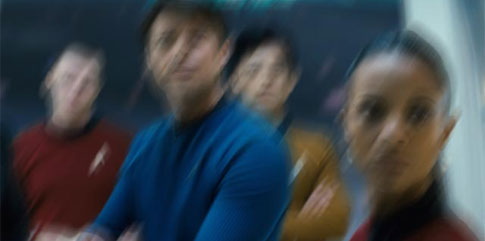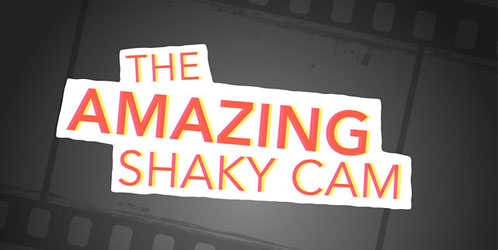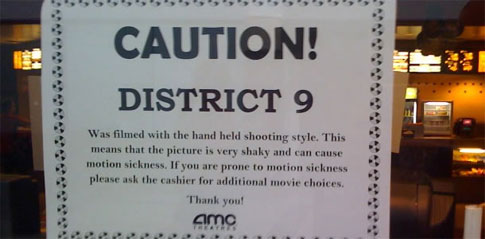There is no worse cinematography trend, or crutch, or just all around ridiculous thing than the stupid, nauseating, uninteresting, overt mound of puke suck, than the interminable shaky-cam. It is a claustrophobic bit of migraine-inducing, vomit-plunging hackmanship that I just can’t abide by anymore.
I’ve decided that any director who relies on the use of shaky-cam to convey that their movie is sensationally real, a gem in the genre of found footage, or as a needed representation of actually being anywhere live and in person — should be shot. Nope. No excuses. No reasoning, or bargaining. If you depend on shaky-cam to sell your movie, you should just be shot. No questions asked.
The genesis of the shaky-cam isn’t some unknowable thing. Most of us can pinpoint when the use of the dry-heaving camera tactic first made its appearance. Some would say, Saving Private Ryan was the first occurrence, and then The Blair Witch Project was its defining moment. Sure, sure, we get it — well perhaps. The dramatic tension in both these films was pretty palpable. We were shown images we didn’t readily see in movies, and the potential for witnessing a docu-drama, or docu-horror, had never before really been shown in the same way prior to Blair Witch, which relied on its ability to sell the audience on some sort of real experience by taking the viewer on a journey inside the fright-filled moments that punctuated nearly every scene. How can we forget what it was like the first time to see the camera fall, and then nearly out of the corner of our eye, and in a way that looked so much like what a home movie would capture — something spooky happened? This was the money shot.
In other movies, say the Bourne franchise, we allowed for the use of shaky-cam to sell us on Bourne’s innate badassery. We understood that in order to really understand and appreciate the lethal pedagogy of Jason Bourne he had to be almost superhuman. He was supposed to be able to do things that no one else would fathom, much less enact perfectly. Beating someone with a magazine is supposed to leave the target, and by extension, the viewer, in a bit of a dizzying tizzy. You’re supposed to exclaim, “How the hell did he do that?” and the shaky-cam was along for the ride, dipping and feinting left, right, as we witnessed Bourne’s inevitable takedown of whichever henchman was up next.
But as we encroached more and more into the new millennium the shaky-cam came right along with us, showing up randomly in movies, inexplicably. Found footage film Cloverfield is another such instance, as well as, District 9, and the horrible, made in a toilet, Battle: Los Angeles and a myriad other films that were drowned in the technique, so much so that there was never a moment to breathe that didn’t have brain torturing shaky-cam doused all over it like some sort of tilt-a-whirl tumor. Even in the quiet moments, even when there was no action, no dialogue, and no earthly need for this “pseudo-realism” there it was, dipping its private parts in your brain’s coffee mug, despite your screaming, your piteous ignored screaming.
What you can imagine started out as a way to emphasize certain points of a film, became some lazy bastardization of filmmaking, a noxious trope in making the world a grittier, more sorrowful place. This is the unimaginative way and pervasive way to cut corners in action sequences, to heighten the adrenaline rush supposedly of the viewer by not giving the movie-goer a place to look and focus before ripping the angle and scene away to another such motion-plagued moment that makes your eyes work for every morsel, to challenge your focus, your ability to absorb, and yes, your stomach’s lurching powers. Needlessly? Yes.
Who asked for this?
Really, filmmakers, who? I’ve yet to encounter anyone, anywhere who enjoys nonstop shaky-cam from opening to closing credits. I’ve never heard anyone say, “This movie was awesome. Too bad I didn’t need Dramamine for more of it, though.” Let’s be honest here. You don’t do this for us, the viewer, you make these shaky-cam intestinal punches for all your film buddies. The stupid, asinine Brett Ratners, Michael Bays, and Jonathan Liebesman [Battle: Los Angeles, Wrath of the Titans, and the upcoming Ninja Turtles] of the movie world, and any other hack filmmaker who should really make his movies on an ice floe in Nova Scotia while drifting out to sea. And we can now count director Gary Ross on that list. Yep, the director of The Hunger Games.
Now, I may have my issues with some of The Hunger Games story, but there was nothing more disheartening when watching one of the most highly anticipated films of the year, to find that it was covered in movie seizures from the very first frame. My excitement upon entering which was probably about a solid 8, plummeted down to a 2, once I realized that the entire thing was filmed in this damnable style. Let’s just say that I’m not upset that Ross has decided not to film the sequel, Catching Fire. I know this probably didn’t happen, but I would’ve been thrilled to see his pink slip from the studio which therein it said, “Fired for Overuse of Stupid Shaky-Cam.” In my view, this is a justifiable reason for ousting. If the story is so unmoving that you need to kick it up a notch with the equivalent of movie cocaine, than boy, the problem isn’t the filming, it’s the writing, and the director, and the producer who agreed that throwing a camera at a wall and seeing what it captured was the way to go.
The worst thing for any avid movie fan is to feel that he or she is being cheated out of a fine film, because you can’t witness the nuance and reaction of the characters, or you can’t see what the monster looks like, or in closing your eyes or averting them for a split second to give them a quick rest, you’ve missed something important.

I’m not a filmmaker, so perhaps I don’t know what the true benefits there are to this trend. Maybe there’s an award ceremony held in Vegas that celebrates bile-rising visuals, and counts how many people leave the theater after enduring nonstop film tourettes, but I would dare say that as a patron, the best bit of “realism” you can offer your audience is letting them watch the damn movie without sticking your signature seizure-fest on every frame. Many a blog has lambasted the use, called it an overused gimmick, a hack ploy to compensate for bad staging, and have time and again called the business of shaky-cam an old, withered tool. Yet, we keep seeing it. So listen up, filmmakers, even you Ratner, Bay, and whoever else, we can only see your vision through a camera lens, so how about we keep it steady, use the shaky-cam sparingly, if at all, and for the love of Zeus, tell your story with skill and not cheap parlor tricks.
I’m asking nicely. Can it with the Shaky-cam.

